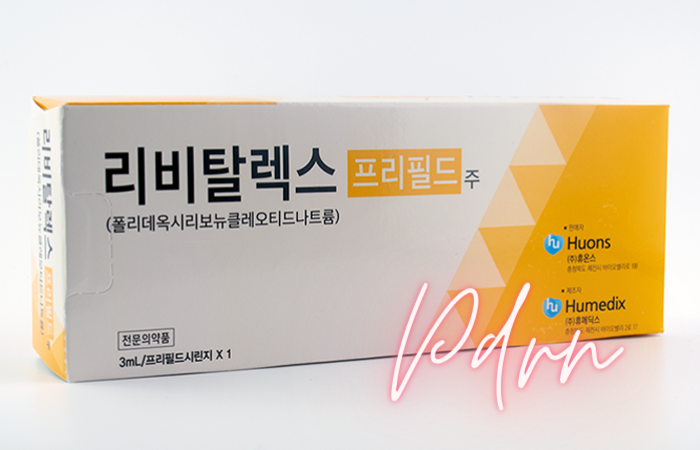
Chances are that, if you’re interested in K-Beauty skin procedures, you’ve heard of PDRN. This is the shortened form of the word Polydeoxyribonucleotide, which is almost always referred to in its shortened form, PDRN, or more simply as ‘Salmon DNA’.
All three describe the same natural compound found in many modern skin boosters. Just as salmon is a well-known superfood, PDRN is skincare’s equivalent.
Still, an important question remains – what is PDRN actually made of?
PDRN holds a mixture of deoxyribonucleotides… derived from a controlled purification and sterilization process of Oncorhynchus mykiss (Salmon Trout) or Oncorhynchus keta (Chum Salmon) sperm DNA”
From “Pharmacological Activity and Clinical Use of PDRN“
Confused by the above? Breaking down the word ‘Polydeoxyribonucleotide’ might make things easier to understand.
You may or may not be surprised to learn that DNA is short for ‘deoxyribonucleic acid’. When looking at PDRN’s chemical name, we can see how much of DNA’s own chemical name appears in the word Polydeoxyribonucleotide.
Now, that just leaves the head and the tail of it (not talking about the salmon itself here!)
Poly is short for polymer, a large molecule which makes up DNA. In PDRN, these polymers are formed by small molecules called nucleotides, which are linked together (there are at least 13 of these in salmon DNA). These nucleotides have special properties that benefit human skin.
Deoxyribose is the sugar ribose, with a missing oxygen atom (‘de-oxy’). This particular sugar, which forms PDRN’s little nucleotides, allows DNA to replicate itself. This is very important, as it indicates that salmon DNA has regenerative potential.
Nucleotides, when arranged correctly within a DNA strand, retain important information that has been inherited from cells. Since PDRN contains all the best bits from salmon DNA, it’s ideal for use in aesthetic skin procedures.
So this is how PDRN came about – a natural polymer (known as a ‘biopolymer’) and DNA with significant anti-ageing benefits.
Does that make things clearer? Maybe not – but we still hope so!
In order to achieve a 95%> level of purity* for injection, PDRN must be carefully extracted from salmon sperm at a high temperature and sterilised. Although salmon sperm may sound off-putting, it is the purest source of PDRN with the least number of contaminants. This makes it very safe to use for aesthetic and regenerative skincare procedures.
As a skin booster, PDRN is often (although not always) suspended in sodium hyaluronate, a non-crosslinked form of hyaluronic acid. In mesotherapy products, PDRN is often combined with other ingredients. Since the combination, strength and quality of these ingredients vary from product to product, this can have an impact on the overall effectiveness of PDRN injection treatments.
Therefore, it’s recommended to check the ingredients list before purchasing any PDRN-based item. Be sure that any additional ingredients included in your chosen PDRN product are suitable for addressing the skin or hair issues you plan on treating.
The manufacturing process impacts the quality of injectable PDRN for other reasons, too. One example is how PDRN’s “binding to adenosine A2A receptors… [is] linked to DNA origin, molecular weight and manufacturing process” (Pharmacological Activity and Clinical Use of PDRN).
As an A2A receptor agonist*, PDRN’s anti-inflammatory effect against ‘inflammaging’ is an important feature of this particular bioactive ingredient. Therefore, before purchasing PDRN injectables, it’s important to investigate the source of the product and whether it was likely to have been produced in a regulated environment by a reputable manufacturer. This will ensure that the activity of PDRN, once injected, will work optimally within the skin and body.
For it to work well in skin rejuvenation procedures, PDRN’s molecular weight should be within the range of 50-1500 kDA. One study found this to be the best range for promoting wound repair, collagen production and stimulating the activity of fibroblasts*.
To this end, it’s important to find injectable PDRN products that fulfil this recommendation. However, few PDRN products state their molecular weight on their packaging.
Very occasionally, it is possible to find the concentration of PDRN per ml on a product’s packaging. If this is not provided, then it is likely that the PDRN product contains low-level traces of this key active ingredient.
It is for the above reasons that we recommend Revitalex PDRN, a KFDA-approved product that contains 5.625mg of Polydeoxyribonucleotide per 3ml – a significant concentration that has been shown to improve a hypertrophic retractive scar after surgery. This is a pure PDRN product that can be combined with other skin boosters such as Hyaron for additional anti-ageing benefits.
Benefits of PDRN Injections
Another good reason to undertake a high-quality PDRN injection treatment relates to its benefits. Here are just a few that can result from one or more treatments:

Two working day UK delivery on orders before 3pm Mon-Fri

Sign up to receive 10% off your first order

Exclusive special offers for customers

9:00AM - 6:00PM GMT Monday to Saturday
NEWSLETTER
Customers
Phone: (+44) 0333 006 7756 | Email: contact@glowup.supply



© 2025 Glow Up Supply. All Rights Reserved. Privacy Policy | Terms of Service

Cookies are used to access and store information on your device, to offer personalised content based on your data. By choosing “I agree” you consent to our use of cookies.
*Discount applies to first orders; shipping excluded.